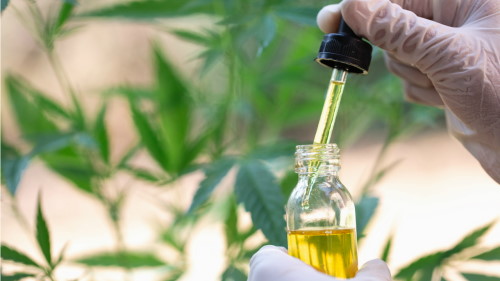Overview
Cannabidiol (CBD) is one of several active compounds found in the cannabis plant.
Although CBD has established benefits for certain mental health conditions, researchers are still trying to understand its effects on behavioral and neurological conditions.
It’s unclear whether CBD, or CBD oil, can help ease symptoms of attention deficit hyperactivity disorder (ADHD).
Here’s what you need to know about the potential benefits, side effects, and more.
What the research says
BREAKING: This Keeps Your Blood Sugar Below 100 - Even When You're Eating Sweets!
Research on CBD as an ADHD treatment is sparse. Much of what we do know stems from research on cannabis as a whole and not CBD as an isolated compound.
Symptom management
Cannabis use and ADHD are both independently associated with impaired attention, inhibition, and functioning.
Because of this, many researchers theorize that cannabis use would worsen existing ADHD symptoms. However, there isn’t any evidence to support or contradict this.
One 2016 study explored the relationship between ADHD, depression, and marijuana use in undergraduate students. Although the researchers established that some students used marijuana to cope with depressive symptoms, its overall effect on these symptoms was unclear.
A 2013 study on ADHD subtypes and cannabis use also delivered interesting results. After collecting data from 2,811 current cannabis users, researchers found that people who used cannabis daily self-reported symptoms of hyperactivity-impulsivity when not using cannabis.
More research is needed to truly understand what benefits, if any, CBD may pose in ADHD management.
Substance use disorder
Other research on cannabis and ADHD focuses on ADHD as a risk factor for developing substance use disorder.
One 2014 study assessed cannabis use and ADHD symptoms in 376 undergraduate students.
The researchers found that both current inattention issues and childhood inattention issues were associated with more severe cannabis use and dependency.
They also found that participants who demonstrated hyperactive-impulsive behavior as children began to use cannabis earlier than participants who didn’t.
A separate 2017 study assessed 197 students in the same age range. It looked more broadly at the role of impulsivity in young adults with ADHD and risk factors for alcohol and drug misuse.
The researchers concluded that young people with ADHD were more likely to use alcohol and recreational drugs.
How CBD works
When you consume CBD oil, the compounds engage with two receptors in your body. These receptors, known as cannabinoid receptor type 1 (CB1) and type 2 (CB2), have a direct effect on specific parts of your body.
CB1 is more abundant in the brain and is directly related to epilepsy. CB2 is more abundant in the immune system. It’s connected to pain and inflammation.
The compounds from CBD appear to trigger your body to use more of the cannabinoids it produces naturally.
The uptick in the use of naturally occurring cannabinoids may lead to a number of benefits, including decreased anxiety and reduced hyperactivity.
Side effects of traditional ADHD treatments
Traditional ADHD medications fall into two categories: stimulants and nonstimulants.
Stimulant ADHD medication is fast-acting and widely used. In fact, 70 to 80 percent of American children diagnosed with ADHD see their symptoms decline when they use this type of medication.
However, stimulant medications aren’t without side effects. These include:
- poor appetite
- weight loss
- headache
- mood changes
- insomnia
- dry mouth
Although nonstimulant medications are less likely to cause side effects, they’re still possible. These may include:
- poor appetite
- weight loss
- headache
- mood changes
- upset stomach
- nausea
- dizziness
- fatigue
Stimulant and nonstimulant medications are prescription-only. You’ll have to see a doctor and undergo regular examinations to continue use.
Side effects of CBD
CBD has been shown to be well-tolerated at doses of up to 1,500 milligrams (mg) per day. Due to a number of factors, it can take anywhere from 20 minutes to two hours before you feel its effects.
The side effects of CBD may include upset stomach, drowsiness, or changes in appetite or weight.
In one study, CBD-rich cannabis extract was shown to increase the risk of liver toxicity in mice. However, the mice in that study received large doses of CBD.
CBD may interact with a number of different supplements, prescription medications, or over-the-counter (OTC) drugs.
CBD, like grapefruit, also interferes with enzymes that are vital to drug metabolism. Before you use CBD, check to see if any of your supplements or medications come with a “grapefruit warning.”
CBD and CBD oil may be available without a prescription in locations where they’re legally available.
How to use CBD oil
CBD oil is typically taken via oral ingestion or vaping.
Oral CBD is considered less likely to cause side effects, so beginners may want to start here. You can put a few drops of the oil under your tongue, take CBD capsules, or even eat a CBD-infused treat.
Inhaling CBD, either through smoking or vaping, delivers the compound to your bloodstream more quickly than other methods. However, the medical community is growing increasingly concerned about vaping and whether it’s safe.
At this time, there aren’t any formal guidelines on how to use CBD oil to treat traditional ADHD symptom such as hyperactivity, fidgeting, and irritability.
Researchers have studied doses for related symptoms, such as anxiety. Although more research is needed, one 2018 study suggests that a single 300-mg dose may be enough to reduce anxiety.
If you’re new to CBD, you should start with the smallest dosage possible. Gradually increasing your dosage will allow your body to get used to the oil and reduce your risk of side effects.
Potential side effects and risks of CBD oil
Some people may experience upset stomach or drowsiness when they first begin taking CBD oil. Starting with a lower dose may help reduce your risk for these side effects.
Other side effects may depend on the way you use the CBD oil.
Vaping, for example, may cause lung damage that can become severe. This can lead to chronic cough, wheezing, and other breathing difficulties that can lead to death.
Due to recent findings by the Centers for Disease Control and Prevention (CDC) regarding vaping or other inhalation methods of CBD and related products, inhalation may not be the safest method to use. This is particularly so if you have asthma or any other type of lung disease.
If you’re unsure about the potential side effects of CBD oil or how your body might handle them, talk with your doctor.
Can you give CBD to children?
Only a few studies or trials have examined the use of CBD in children. This is a result of the stigma associated with marijuana, its psychoactive compound tetrahydrocannabinol (THC), and CBD.
To date, Epidiolex is the only CBD product that’s been approved by the Food and Drug Administration (FDA). Epidiolex is a prescription drug used to treat rare and severe forms of epilepsy. It’s approved for use in both children and adults.
Most reports on CBD in children are case studies or individual anecdotes reported through doctors or researchers.
For example, one 2013 report asked parents in California to complete a Facebook poll about giving CBD-enriched cannabis to their child to treat epilepsy. Nineteen parents reported administering it to their child. Side effects included drowsiness and fatigue.
In a similar 2015 Facebook poll, 117 parents of children with epilepsy reported safely administering CBD products to their child. These parents reported improvements in sleep, alertness, and mood with regular CBD use.
Like these polls, many of the individual testimonials around the use of CBD in children focus on those with epilepsy. Some reports have focused on conditions such as autism and post-traumatic stress disorder (PTSD).
Since evidence is anecdotal and CBD hasn’t been studied specifically to treat ADHD in children, it’s best to talk to your child’s pediatrician before giving your child CBD.
TRENDING: Newly Legalized Herb Relieves Pain - Available Without A Prescription
Will it get you high?
CBD isn’t the same thing as medicinal marijuana.
Although CBD oils are made from cannabis, they don’t always contain THC. THC is the component that makes users feel “high” or “stoned” when smoking marijuana.
CBD isolate and broad-spectrum CBD products don’t contain THC, so they won’t cause any psychoactive effects. Full-spectrum CBD products derived from hemp do contain a very small amount of THC (0.3 percent or less), so they won’t cause any psychoactive effects either.
Full-spectrum CBD products derived from marijuana may contain THC in greater amounts. However, even if you select a full-spectrum product that contains a high proportion of THC, you still may not experience any psychoactive effects. A 2010 study found that CBD may counteract THC, inhibiting its psychoactive effects.
Is it legal?
Although CBD products are widely available, they aren’t always legal. Make sure you’re aware of any local, state, or federal laws before seeking out the product.
Many types of CBD are derived from hemp products. Because of the 2018 farm bill, hemp products are legal in the United States if they contain less than 0.3 percent THC. THC is one of the active ingredients in marijuana.
Marijuana-derived CBD is only legal in certain states. That’s because these products may contain trace amounts of THC.
Although CBD is less restricted internationally, some countries may have laws regulating its use.
Talk to a doctor or another healthcare provider
More research is needed before CBD oil becomes a conventional treatment option for ADHD, but it’s worth talking to your doctor if you’re interested. They can help advise you on the proper dosage, as well as any legal requirements.
If you decide to try CBD oil, treat it like you would any other tool for symptom management. It may take some time to work, and you may need to adjust your dosage to better suit your needs.









